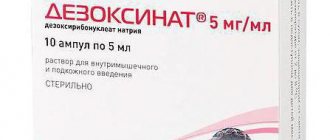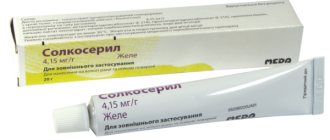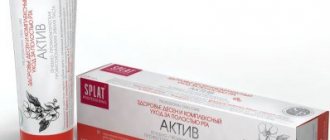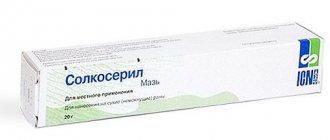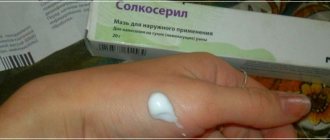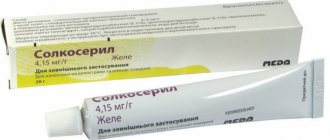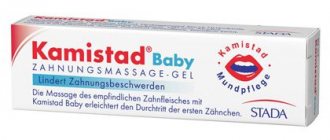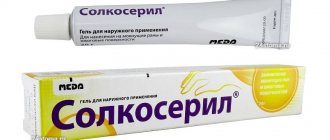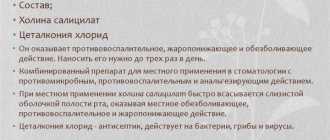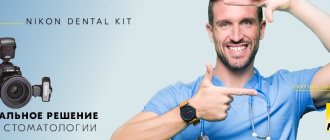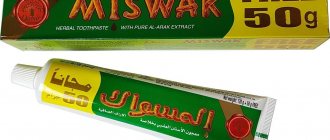From this article you will learn:
- indications for use,
- instructions for use in the oral cavity,
- composition analysis, analogues, price 2022.
The article was written by a dentist with more than 19 years of experience.
Solcoseryl dental adhesive paste is a dental preparation based on deproteinized dialysate from the blood of calves, which is intended to accelerate the healing of ulcers, erosions and traumatic injuries of the oral mucosa. The drug can only be used on moist mucous membranes and, accordingly, it is not suitable for the treatment of wounds and skin lesions. In the latter cases, you should use Solcoseryl forms - in the form of a gel or ointment.
The drug is produced by an international pharmaceutical company and is registered as a “medicinal product”. In addition, it has no age restrictions and is available without a prescription. Solcoseryl dental paste has the appearance of a pale yellow homogeneous granular mass. If you squeeze the paste out of the tube, you will notice that it has a slightly dry consistency. Despite this, the paste is easily distributed and firmly fixed on the oral mucosa, while also performing the function of a protective bandage. The latter is very important, because if there are erosions on the mucous membrane, eating will be very painful.
Solcoseryl dental paste: photo of packaging
Indications for use –
- for stomatitis – to accelerate the healing of ulcers and relieve pain (Fig. 3),
- after surgical operations in the oral cavity,
- bedsores under dentures
- for the treatment of jamming in the corners of the mouth,
- to accelerate the healing of the socket of an extracted tooth with alveolitis (Fig. 4).
This article was written by a dental surgeon, and in some cases that require clarification, the optimal solution for these indications will still be not adhesive dental paste, but Solcoseryl in gel form. In our opinion, for stomatitis, the paste will be optimal only in the presence of deep ulcerations, and for superficial erosions it will be better to use a gel. The same applies to the treatment of bedsores under dentures. For a detailed description of the use of the drug, read below.
pharmachologic effect
Combined preparation for local use, stimulator of tissue regeneration.
The drug is a chemically and biologically standardized deproteinized dialysate obtained from the blood of healthy dairy calves using the ultrafiltration method. Contains a wide range of natural low-molecular compounds weighing up to 5000 Daltons: glycolipids, nucleosides and nucleotides, amino acids, oligopeptides, trace elements, electrolytes, intermediate products of carbohydrate and fat metabolism. Activates the transport of oxygen and nutrients at the cellular level, increases oxygen consumption by the cell, stimulates ATP synthesis, enhances the proliferation of reversibly damaged cells, especially under hypoxic conditions, thereby accelerating wound healing processes. Stimulates angiogenesis, promotes revascularization of ischemic tissue, as well as creating conditions favorable for collagen synthesis and the growth of fresh granulation tissue, accelerates re-epithelialization and wound closure. The drug also has membrane-stabilizing and cytoprotective effects.
Polidocanol 600 - local anesthetic; acts in the area of peripheral nerve endings, causing their reversible blocking. It has a quick and long-lasting local anesthetic effect. After applying the paste to the oral mucosa, the pain stops within 2-5 minutes; pain relief lasts for 3-5 hours.
Solcoseryl dental adhesive paste forms a protective healing layer on the affected area of the oral mucosa and protects it from mechanical and chemical damage for 3-5 hours, performing the function of a medicinal bandage.
Solcoseryl dental adhesive paste: reviews
Solcoseryl paste will have a pronounced effect and accelerate the healing of wounds, erosions and ulcers, provided that they are not related to tumor-like lesions. The benefits of the drug are undeniable if you use it in accordance with these instructions. The form of Solcoseryl in the form of a dental adhesive paste is especially convenient if you need the drug to also act as a protective medical dressing (for example, after surgical interventions).
In many other cases (for stomatitis, for the treatment of bedsores under dentures), it is actually more convenient to use Solcoseryl not in the form of a paste, but in the form of a gel. The latter is also cheaper, and the volume of the tube is 4 times larger. But the paste is most convenient for the treatment of alveolitis (to accelerate the epithelization of the “empty socket” and relieve pain), use after surgical operations in the oral cavity, and especially for the treatment of deep ulcers.
Once again, we draw your attention to the fact that long-term non-healing ulcers can be a symptom of tumor growth. And if you have a history of such an ulcer or if there is no effect from using Solcoseryl, you should definitely consult a dental surgeon for advice.
Directions for use and dosage
The drug is intended for local use on the oral mucosa.
The affected surface of the mucous membrane must first be dried with a cotton or gauze swab. Apply a strip of paste about 0.5 cm long, without rubbing, onto the mucous membrane in a thin layer with your finger or using a cotton swab, and then lightly moisten the applied paste with water. The procedure is repeated 3-5 times a day after meals and before bedtime. Treatment is carried out until symptoms disappear.
Solcoseryl dental adhesive paste forms a protective therapeutic layer on the affected area of the oral mucosa and protects it from mechanical and chemical damage for 3-5 hours. When applying the paste to undried mucosa, the duration of the therapeutic effect can be reduced.
When treating bedsores from removable dentures, apply the paste to a dry denture and moisten with water.
The recommended course dose of the drug is 1 tube (5 g).
What types are there?
Previously, Solcoseryl was produced only in the form of an ointment, but the manufacturer has significantly expanded its product range:
- Gel. To fix the gel on the mucous membrane, you need to thoroughly treat the desired area with an antimicrobial agent, then wipe it dry with sterile gauze.
- Paste. Perhaps this is the most successful option, ideal for use within the oral cavity. The paste does not spread and holds well; it is often prescribed by dentists for the treatment of gums.
- Ointment. Solcoseryl in ointment form is not used for dental purposes. Due to its too greasy consistency, the product instantly spreads over the gums and is washed off with saliva. This option is most suitable for treating skin.
- Pills. They are used for oral administration for ulcerative lesions of the mucous membrane or for rapid tissue regeneration, for example, after a complex tooth extraction.
Solcoseryl or Methyluracil – which is better?
Manufacturer: JSC BIOCHIMIC (Russia)
Release form: tablets, ointment, suppositories
Active ingredient: dioxomethyltetrahydropyrimidine
Both medications have regenerating properties, but differ in their mechanism of action. When comparing them, Solcoseryl will be better than Methyluracil, since it has a minimum of side effects and contraindications, exceeding the number of dosage forms.
A large number of Solcoseryl analogues is an additional opportunity to select appropriate medications for the treatment of wounds and ulcers. Fast and effective regeneration of the damaged area of the skin can prevent the development of inflammation, accelerating the process of restoring the integrity of the skin.
Special instructions -
- The drug is safe for use in children, including infants.
- Solcoseryl dental adhesive paste cannot be applied to an infected wound, because it does not contain antimicrobial components.
- Before applying the paste, always treat the application area with an antiseptic.
- If fever appears, as well as redness, pain and swelling in the area of the mucous membrane near the site of application of Solcoseryl, or if discharge appears from the wound, you should consult a doctor.
- If, when using the drug, the ulcer does not heal within 10 days, you should also consult a doctor, because this may indicate oncology. We hope that our article on the topic: Solcoseryl dental adhesive paste instructions - turned out to be useful to you!
Sources:
1. Dental education of the author of the article, 2. Personal experience as a maxillofacial surgeon, dental surgeon, 3. Official website of the manufacturer – https://solcolife.ru/, 4. “Outpatient surgical dentistry” (Bezrukov V.), 5 . "Therapeutic dentistry. Textbook" (Borovsky E.).
Analogues of Solcoseryl ointment
The pharmacological market offers expensive and cheap analogues of Solcoseryl, which are not inferior and sometimes even superior to the main drug in their therapeutic effect.
What can replace Solcoseryl ointment? The most common means are:
- Bepanten – has a regenerating, anti-inflammatory, metabolic effect. This ointment can be used as an analogue of Solcoseryl for children, relieving diaper rash and diaper dermatitis in infants.
- Propolis ointment - restores the affected areas of the skin due to the natural composition of the ointment, which includes minerals, trace elements, amino acids.
- Panthenol – has regenerative and anti-inflammatory properties, stimulating healing and restoration of skin structure in case of injuries, burns of various origins, and some diseases (dermatitis, trophic ulcers).
- Stellanin - has a stimulating effect on tissue regeneration and protects the wound surface from infection, suppressing the progression of the process due to the active iodine included in the product.
- Argosulfan - has an antimicrobial effect, effectively protecting wounds of various etiologies from infection and promoting their speedy healing.
A wide variety of analogues of Solcoseryl ointment allows you to combine products, achieving the best therapeutic effect and reducing the recovery time for damaged skin.
Solcoseryl or Metrogyl denta - which is better?
Manufacturer: UNIQUE PHARMACEUTICAL LABORATORIES (India)
Release form: dental gel
Active ingredient: metronidazole, chlorhexidine
Metrogyl denta and Solcoseryl have different active substances and mechanisms of action, but the same therapeutic effect. Solcoseryl will be the best, since it has more dosage forms, which makes it possible to treat dry wound surfaces with secretions.
Metrogyl denta has a smaller range of indications and is used for the treatment of affected oral mucosa.
Analogues of Solcoseryl
The domestic and foreign pharmaceutical industry produces a large number of analogues of Solcoseryl ointment for the skin, which have similar properties. They are sold to the pharmacy chain in the form of:
- synonyms;
- generics;
- combined means.
A wide variety of Solcoseryl substitutes make it possible to select the most effective means for the treatment of wounds and ulcers of various etiologies.
Table of Solcoseryl analogues with price and country of origin.
| Analogue | Cost in rubles | Manufacturer country |
| Solcoseryl | 410–600 | Switzerland |
| Actovegin | 580–1550 | Austria |
| Metrogyl denta | 250–270 | India |
| Levomekol | 120–140 | Russia |
| Methyluracil | 65–160 | Russia |
| Bepanten | 390–700 | Germany |
| Propolis ointment | 120–150 | Russia |
| Panthenol | 130–320 | Croatia |
| Stellanin | 380–420 | Russia |
| Argosulfan | 390–600 | Poland |
| Contratubeks | 570–960 | Germany |
| Holisal | 280–510 | Poland |
| Vitadent | 110–320 | Russia |
| Dentokind | 580–600 | Germany |
The price of Solcoseryl analogues fluctuates over a wide range. A large selection of these drugs allows the patient to purchase cheap analogs of Solcoseryl, depending on the indications and the condition of the wound surface.
Contraindications –
The only contraindication is hypersensitivity to one of the components of the drug. Solcoseryl "Denta" is not contraindicated during pregnancy and breastfeeding. It should be used with caution only if you have severe allergic reactions. The drug contains a residual amount of parahydroxybenzoic acid (E 210), which is important to take into account in patients with allergic reactions to this component.
Allergic reactions usually develop in the form of slight swelling at the site of application of the drug. In this case, you must stop using the drug and also take an antihistamine tablet. Also, an allergic reaction may be indicated by a burning sensation at the site of application of the drug. Moreover, a slight burning sensation (which goes away almost immediately after application) does not require discontinuation of the drug. The latter is necessary only if the burning sensation is permanent.
Questions
Solcoseryl ointment or gel – which is better, what’s the difference?
The texture of the gel is lighter than ointment and does not contain fatty inclusions. It will be the best, as it is able to penetrate deeper into the tissue and have a faster healing effect.
Solcoseryl - hormonal ointment or not?
No, Solcoseryl ointment is not hormonal.
Solcoseryl gel or ointment – which is better for the face?
In cosmetology, both Solcoseryl gel and ointment are used for the face.
What is better for wrinkles: Solcoseryl gel or ointment?
Solcoseryl Ointment is used for wrinkles.
Solcoseryl - hormonal or not?
No, Solcoseryl gel is not hormonal.
Solcoseryl - instructions for use
According to the instructions for use of Solcoseryl, the product is applied to the wound surface, having previously treated it with a disinfectant solution. Purulent wounds or trophic ulcers require surgical treatment of the wound surface before treatment.
Solcoseryl gel is used on fresh wounds with moist secretions 2-3 times a day. The ointment form of the product is applied only to a dry wound surface 1-2 times a day. The combined use of external and parenteral administration of Solcoseryl is indicated for severe trophic ulcers of the skin or soft tissues.
